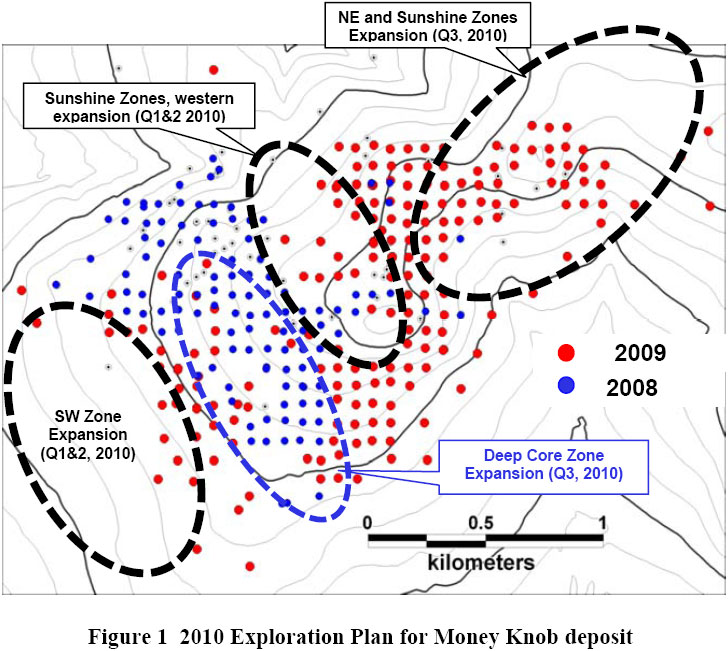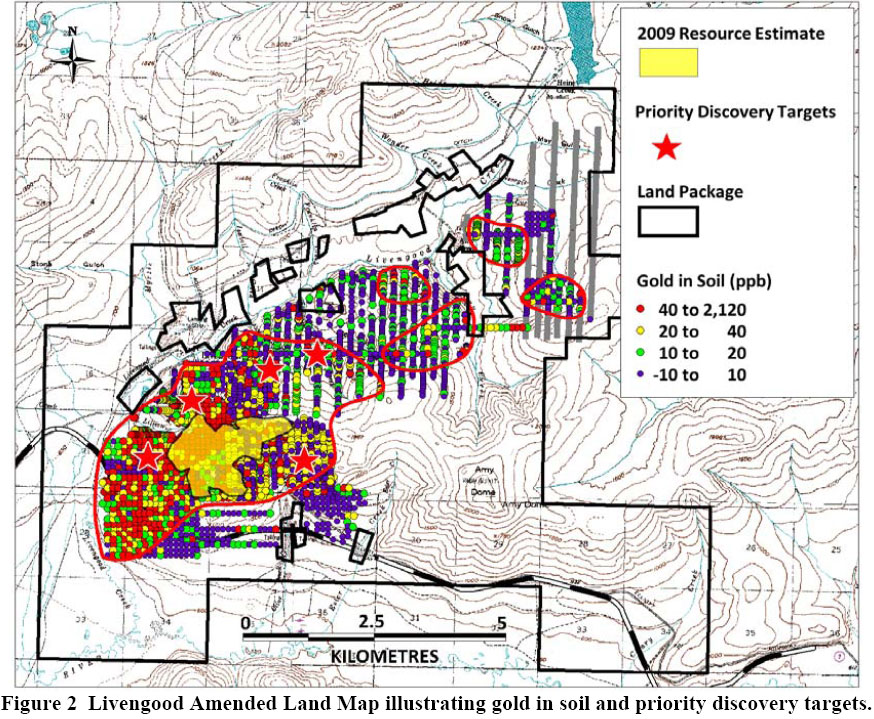Vancouver, B.C.......International Tower Hill Mines Ltd. ("ITH" or the "Company") - (TSX: ITH, NYSE-A: THM, Frankfurt: IW9) is pleased to announce the start of the first phase of its planned 50,000 metre 2010 exploration drill program at Livengood Gold Project, Alaska. The initial phase of this program is the 2010 Winter drilling program, which focuses primarily on the expansion of the Southwest and Western parts of the Money Knob deposit containing the highest grade portion of the deposit discovered to date. In addition, the highly prospective area between the Sunshine and Core Zones will be infill drilled (Figure 1) during the Winter program.
The Winter 2010 program utilizes four drills, which will operate 24 hours a day until the middle of April, targeting the completion of over 20,000 metres of core and reverse circulation drilling. The results from the Winter drill program will be included in a resource update scheduled for the end of the second quarter of 2010.
Click to Enlarge

Effective January 1, 2010, the Company has amended its existing Livengood project lease with the Alaska Mental Health Land Trust (AMHLT) to increase the leased fee simple land by approximately 25 square kilometres. With this major expansion of the lease, the Livengood project now covers approximately 70 square kilometres, which includes additional potential exploration areas and surface mine facility sites (Figure 2). The amended lease will provide the Company with full flexibility for multiple development scenarios at the Livengood project.
Click to Enlarge

The Company's independent consultants are currently working on a resource update to incorporate the final 70 holes drilled in the 2009 Summer program which are dominantly from the Sunshine, Northeast and Money Knob Zones of the deposit. This resource update is currently targeted for release in the near future.
As part of its project optimization work at Livengood, the Company is conducting its initial metallurgical milling recovery tests to assess the viability of using a variety of milling techniques to enhance gold recovery and maximize the economic performance of the project. The Company has been releasing this data as it has come available and expects to continue this during the next several weeks. Results to date have been encouraging for the integration of milling into the production plan.
Livengood Project Highlights
- Ongoing drilling at the project continues to expand the deposit at a rapid rate, with the current estimated resource open for expansion. The latest resource estimate (October 2009) of 296.8 Mt indicated at an average grade of 0.85 g/t gold (8.09 Moz) and 164.2 Mt inferred at an average grade of 0.84 g/t gold (4.4 Moz), both at a 0.5 g/t gold cutoff, makes it one of the largest new gold discoveries in North America.
- The recently completed initial PEA shows that, with a USD 850/oz gold price, mining the oxide portion of the deposit using a heap leach only operation could yield 5.8M recoverable ounces of gold with an NPV(5%) of USD 440M and an IRR of 14.6% over a 13 year mine life.
- Ongoing metallurgical studies focusing on the mill potential are underway and the next PEA will consider a combined Mill and Heap Leach operation. Preliminary results indicate that, on average, 56% of the gold reports to a gravity concentrate and that carbon in leach processing of tails will provide significant additional recovery. Final results of these studies are expected in Q1 2010.
- The geometry of the currently defined shallowly dipping, outcropping deposit is such that the initial PEA indicates an overall strip ratio of 0.78:1 (waste to ore) in the USD 700 pit.
- No major permitting hurdles have been identified to date.
The Company wishes to emphasize that the Livengood project has a very favourable logistical location, being situated 110 road kilometres north of Fairbanks, Alaska along the paved, all weather Elliott Highway, the Trans Alaska Pipeline Corridor, and the proposed Alaska natural gas pipeline route. The terminus of the Alaska State power grid lies approximately 55 kilometres to the south.
Project Background
ITH controls 100% of its 70 square kilometre Livengood land package, which is primarily made up of fee land leased from the Alaska Mental Health Land Trust and a number of smaller private mineral leases. The Company and its predecessor, AngloGold Ashanti (U.S.A.) Exploration Inc., have been exploring the Livengood area since 2003, with the project's first indicated resource estimate being announced in early 2008. The 2009 drilling program was part of a series of drill initiatives which mark the first grid drilling resource definition campaign for the project and is only the initial step in what the Company envisions as a major long-term exploration program to define one of the world's larger new gold deposits.
Geological Overview
The Livengood Deposit is hosted in a thrust-interleaved sequence of Proterozoic to Palaeozoic sedimentary and volcanic rocks. Mineralization is related to a 90 million year old (Fort Knox age) dike swarm that cuts through the thrust stack. Primary ore controls are a combination of favourable lithologies and crosscutting structural zones. In areas distal to the main structural zones the selective development of disseminated mineralization in favourable host rocks is the main ore control. Within the primary structural corridors all lithologies can be pervasively altered and mineralized. Devonian volcanic rocks and Cretaceous dikes represent the most favourable host lithologies and are pervasively altered and mineralized throughout the deposit. Two dominant structural controls are present: 1) the major shallow south-dipping faults which host dikes and mineralization which are related to dilatant movement on structures of the original fold-thrust architecture during post-thrusting relaxation, and 2) steep NNW trending linear zones which focus the higher-grade mineralization which cuts across all lithologic boundaries. The net result is broad flat-lying zones of stratabound mineralization around more vertically continuous, higher grade core zones with a resulting lower strip ratio for the overall deposit and higher grade areas that could be amenable for starter pit production.
The surface gold geochemical anomaly at Livengood covers an area 6 kilometres long by 2 kilometres wide of which an area approximately 3 kilometres by 1.5 kilometres has been explored by drilling to date. Surface exploration is ongoing as new targets are developed to the northeast of the known mineralization.
Qualified Person and Quality Control/Quality Assurance
Jeffrey A. Pontius (CPG 11044), a qualified person as defined by National Instrument 43-101, has supervised the preparation of the scientific and technical information that forms the basis for this news release and has approved the disclosure herein. Mr. Pontius is not independent of ITH, as he is the President and CEO and holds common shares and incentive stock options.
The work program at Livengood was designed and is supervised by Dr. Russell Myers, Vice President, Exploration, and Chris Puchner, Chief Geologist (CPG 07048), of the Company, who are responsible for all aspects of the work, including the quality control/quality assurance program. On-site personnel at the project photograph the core from each individual borehole prior to preparing the split core. Duplicate reverse circulation drill samples are collected with one split sent for analysis. Representative chips are retained for geological logging. On-site personnel at the project log and track all samples prior to sealing and shipping. All sample shipments are sealed and shipped to ALS Chemex in Fairbanks, Alaska for preparation and then on to ALS Chemex in Vancouver, B.C. for assay. ALS Chemex's quality system complies with the requirements for the International Standards ISO 9001:2000 and ISO 17025: 1999. Analytical accuracy and precision are monitored by the analysis of reagent blanks, reference material and replicate samples. Quality control is further assured by the use of international and in-house standards. Finally, representative blind duplicate samples are forwarded to ALS Chemex and an ISO compliant third party laboratory for additional quality control.
About International Tower Hill Mines Ltd.
International Tower Hill Mines Ltd. is a resource exploration company, focused in Alaska and Nevada, which controls a number of exploration projects representing a spectrum of early stage to the advanced multimillion ounce gold discovery at Livengood. ITH is committed to building shareholder value through new discoveries while maintaining a majority interest in its key holdings, thereby giving its shareholders the maximum value for their investment.
On behalf of
INTERNATIONAL TOWER HILL MINES LTD.
(signed) Jeffrey A. Pontius
Jeffrey A. Pontius,
President and Chief Executive Officer
Contact Information:
Quentin Mai, Vice-President - Corporate Communications
E-mail: [email protected]
Phone: 1-888-770-7488 (toll free) or (604)683-6332 / Fax: (604) 408-7499
Cautionary Note Regarding Forward-Looking Statements
This press release contains forward-looking statements within the meaning of Section 27A of the Securities Act and Section 27E of the Exchange Act. All statements, other than statements of historical fact, included herein including, without limitation, statements regarding the anticipated content, commencement and cost of exploration programs, anticipated exploration program results, the discovery and delineation of mineral deposits/resources/reserves, the potential for the expansion of the estimated resources at Livengood, the potential for any production at the Livengood project, the completion of a revised preliminary economic analysis of the Livengood project, the potential low strip ratio of the Livengood deposit being amenable for low cost open pit mining that could support a high production rate and economies of scale, the potential for cost savings due to the high gravity concentration component of some of the Livengood mineralization, business and financing plans and business trends, are forward-looking statements. Information concerning mineral resource estimates also may be deemed to be forward-looking statements in that it reflects a prediction of the mineralization that would be encountered if a mineral deposit were developed and mined. Although the Company believes that such statements are reasonable, it can give no assurance that such expectations will prove to be correct. Forward-looking statements are typically identified by words such as: believe, expect, anticipate, intend, estimate, postulate and similar expressions, or are those, which, by their nature, refer to future events. The Company cautions investors that any forward-looking statements by the Company are not guarantees of future results or performance, and that actual results may differ materially from those in forward looking statements as a result of various factors, including, but not limited to, variations in the nature, quality and quantity of any mineral deposits that may be located, variations in the market price of any mineral products the Company may produce or plan to produce, the Company's inability to obtain any necessary permits, consents or authorizations required for its activities, the Company's inability to produce minerals from its properties successfully or profitably, to continue its projected growth, to raise the necessary capital or to be fully able to implement its business strategies, and other risks and uncertainties disclosed in the Company's Annual Information Form filed with certain securities commissions in Canada and the Company's annual report on Form 40-F filed with the United States Securities and Exchange Commission (the "SEC"), and other information released by the Company and filed with the appropriate regulatory agencies. All of the Company's Canadian public disclosure filings may be accessed via www.sedar.com and its United States public disclosure filings may be accessed via www.sec.gov, and readers are urged to review these materials, including the technical reports filed with respect to the Company's mineral properties.
Cautionary Note Regarding References to Resources and Reserves
National Instrument 43 101 - Standards of Disclosure for Mineral Projects ("NI 43-101") is a rule developed by the Canadian Securities Administrators which establishes standards for all public disclosure an issuer makes of scientific and technical information concerning mineral projects. Unless otherwise indicated, all resource estimates contained in or incorporated by reference in this press release have been prepared in accordance with NI 43-101 and the guidelines set out in the Canadian Institute of Mining, Metallurgy and Petroleum (the "CIM") Standards on Mineral Resource and Mineral Reserves, adopted by the CIM Council on November 14, 2004 (the "CIM Standards") as they may be amended from time to time by the CIM.
United States shareholders are cautioned that the requirements and terminology of NI 43-101 and the CIM Standards differ significantly from the requirements and terminology of the SEC set forth Industry Guide 7. Accordingly, the Company's disclosures regarding mineralization may not be comparable to similar information disclosed by companies subject to the SEC's Industry Guide 7. Without limiting the foregoing, while the terms "mineral resources", "inferred mineral resources" and "indicated mineral resources" are recognized and required by NI 43-101 and the CIM Standards, they are not recognized by the SEC and are not permitted to be used in documents filed with the SEC by companies subject to Industry Guide 7. Mineral resources which are not mineral reserves do not have demonstrated economic viability, and United States shareholders are cautioned not to assume that all or any part of a mineral resource will ever be converted into reserves. Further, inferred resources have a great amount of uncertainty as to their existence and as to whether they can be mined legally or economically. It cannot be assumed that all or any part of the inferred resources will ever be upgraded to a higher resource category. In addition, the NI 43-101 and CIM Standards definition of a "reserve" differs from the definition adopted by the SEC in Industry Guide 7. In the United States, a mineral reserve is defined as a part of a mineral deposit which could be economically and legally extracted or produced at the time the mineral reserve determination is made.
This press release is not, and is not to be construed in any way as, an offer to buy or sell securities in the United States. |


